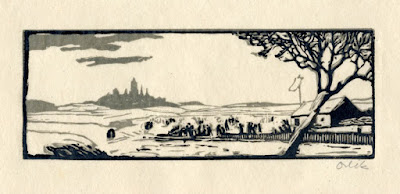Recently I stumbled over this fumbled black and gray woodblock sheet. Just two blocks were used to create this print with great perspective and composition ! Faithful reader Wolfgang helped me to read the signature: "Gleichmann" leading to this new to me artist and a new entry in my ongoing project: the German Women early printmakers index.
Studying in Berlin 1908-1912 and working in nearby Potsdam until 1918 she could very well have had acces to Emil Orliks printmaking classes. Just this morning in German Ebay this Orlik black and gray print appeared: "Eislaufplatz".
Studying in Berlin 1908-1912 and working in nearby Potsdam until 1918 she could very well have had acces to Emil Orliks printmaking classes. Just this morning in German Ebay this Orlik black and gray print appeared: "Eislaufplatz".
I would very much like to know which harbor or quay the artist is showing: Potsdam, Berlin, Hannover ? There's a very interesting contraption shown over the barrels being unloaded. A sheltered hoisting device ? All help is welcomed.
Here's my freshly composed biography:
Gleichmann-Giese,
Lotte
(Aurich,
Ostfriesland 20-03-1890 – 06-04-1975 Hannover)
German painter, graphic artist and printmaker.
Started painting as a child, studied 1908-1912 at Breslau “Kunstakademie” followed by studying philosophy, literature and history of Art in Berlin. In 1915 she married painter Otto Gleichmann (1887-1963) whom she’d probably met while studying
in Breslau working until 1918 as a teacher in Potsdam and Hannover. Joined with
her husband the Hannover Secession in 1918. In the mid 1920’s she co-founded
the painter group GEDOK in Hannover serving as board and chairwomen. She
stopped working as an artist during the Nazi regime while her husbands works
was declared entarted (degenerate). Most of her work was destroyed in the allied bombing of
Hannover. Exhibited in Düren (1915) and Bielefeld (1917) and in the 1920’s in
Oslo and Switzerland. In 2016 a print of an unloading barrels sailing vessel
showed up in German Ebay, signed “Gleichmann”, most probably by her hand.
Dresslers Kunsthandbuch 1921: Hannover, Ubbenstraße
4.
Dresslers Kunsthandbuch 1930: Hannover, Freytagstraße
19.
GEDOK: “Gemeinschaft
Deutscher und Oesterreichischer Künstlerinnenvereine aller Kunstgattungen“, founded 1926 in Hamburg by Jewish Ida
Dehmel (1870-1942)
Gleichmann, Otto Bernard Max
(Mainz,
20-08-1887 – 02-11-1963 Hannover).



No comments:
Post a Comment